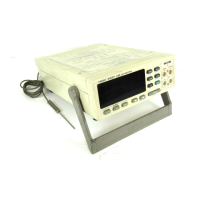74
────────────────────────────────────────────────────
8.3 Introduction for the GP-IB
────────────────────────────────────────────────────
Data is present in the output queue
bit 7
bit 5
bit 4 bit 3 bit 2 bit 1 bit 0
ESB MAV
bit 6
RQS
MSS
Logical sum
&
& & &
Status byte register (STB
bit 7 bit 6
bit 5
bit 4 bit 3 bit 2 bit 1 bit 0
× ESB MAV
・・・ ・・・・・・・・・・・ ・・・
The 3227 has an input buffer of 300 bytes capacity. If the data accumulated in
this buffer exceeds 300 bytes, and the buffer becomes full, the GP-IB interface
bus goes into the waiting state until a space again becomes available in the
buffer.
In its implementation of the serial polling function using service requests, the
3227 employs the status model specified by IEEE 488.2.
The item "event" refers to any phenomenon which generates a service request.
Generation of service requests
The status byte register holds the information relating to the event registers
and the output queue. It is possible to use the service request enable register
as a mask to select the items required. When the selected information is set,
bit 6 of the status byte register (the master summary status or MSS bit) is set,
an RQS message is generated, and this generates a service request.

